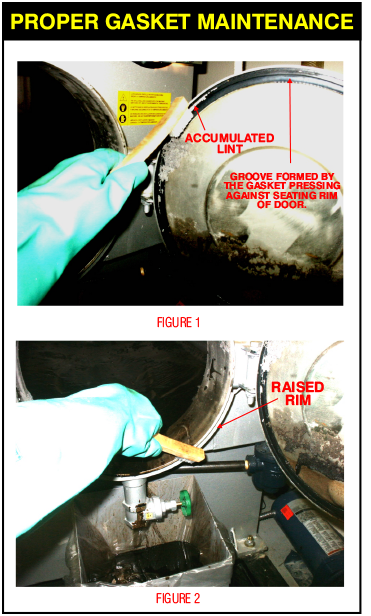stop that expensive leaks

Bruce Grossman
In a bygone era of cheap solvent, transfer machinery and Per Combo filters and cooker stills a drip was generally no big deal. However, the increasing costs of solvent and energy, coupled with environmental regulations, should markedly sharpened our maintenance and housekeeping practices. I’m dedicating the next few articles to the selection of/and techniques involved, with maintaining and replacing that ubiquitous device often taken for granted, the “lowly gasket”.
Stills have them, dry cleaning machines have them, dryers have them, pumps have them, everywhere you look in a dry-cleaning plant you find them. They’re everywhere. GASKETS, that’s what I’m talking about!
With this in mind, beginning with the dry-cleaning machine we find what are probably the 4 most recognizable gaskets you deal with on a daily basis; the loading door, button trap door, lint trap door (on many dry-cleaning machines the lint and button trap are enclosed in the same housing) and still door. These doors are opened and closed on a regular basis causing wear and failure of the gaskets designed to seal them shut. Even the most unaware operator cannot long ignore a solvent leak at the loading door. However, you’d be surprised at how few operators take the time to go behind the machine with a good flashlight and observe the still door during heavy distillation. In many cases a grungy still waste container sits under the still door and the surrounding area is often caked with old still residue. Because of this, even large leaks can go undetected if the timing and lighting are not right (the price of solvent being what it is, these liquid type leaks cost you big time). Also because of the heat and chemistry sight glasses in stills have a high rate of failure and when faulty will leak lots of solvent. Lint and button trap leaks are usually of the vapor variety and harder to locate because the escaping vapor doesn’t usually leave behind a visible a residue. Now that you are aware of the problem areas let’s explore them one by one and see how you can isolate the leaking area and stop the fluid loss.
When you notice a solvent leak at a door it will almost always appear to be located at the bottom area of the door gasket. That’s because gravity being what it is, the liquid solvent leaking past the gasket rolls down the surface of the door and drips off of the bottom center. When you see a leak like this you need to take action at the end of the load that’s currently being processed or the case of a still, the next time the still is cold. Not to worry, chances are good a simple fix will get you back on track.
 When the door can be safely opened, look at the surface of the gasket. Generally, there will be a slight groove in the gasket caused by the pressure against the raised rim portion on the dry-cleaning machine that the door seals against (see figure 1). Often lint accumulates in this groove and prevents the proper mating of the gasket against the machine front. It is a vital to routinely clean this groove, keeping it free from lint. Also, the surface of the raised rim (see figure 2) that the gasket seats on must be kept lint free. On newer machines the rubber of this gasket is a solid robust type and can be cleaned easily with a small wire brush (if the gasket is a type of foam use something more delicate like a spotting bone). The photographs accompanying this article show the cleaning of the still door gasket. The same procedure holds true for all the doors on the machine. A spotting brush is shown being used to clean the gasket. In many cases the bristles may be too soft to remove caked on lint. Brushes with brass or stainless bristles can be used on solid rubber gaskets. Operate the machine and see if the leak has stopped. If after cleaning the gasket, the door still leaks you have a choice to make. Do you want to order a new gasket for replacement or spend the time and effort to attempt an adjustment to the door and/or gasket in order to effect a repair?
When the door can be safely opened, look at the surface of the gasket. Generally, there will be a slight groove in the gasket caused by the pressure against the raised rim portion on the dry-cleaning machine that the door seals against (see figure 1). Often lint accumulates in this groove and prevents the proper mating of the gasket against the machine front. It is a vital to routinely clean this groove, keeping it free from lint. Also, the surface of the raised rim (see figure 2) that the gasket seats on must be kept lint free. On newer machines the rubber of this gasket is a solid robust type and can be cleaned easily with a small wire brush (if the gasket is a type of foam use something more delicate like a spotting bone). The photographs accompanying this article show the cleaning of the still door gasket. The same procedure holds true for all the doors on the machine. A spotting brush is shown being used to clean the gasket. In many cases the bristles may be too soft to remove caked on lint. Brushes with brass or stainless bristles can be used on solid rubber gaskets. Operate the machine and see if the leak has stopped. If after cleaning the gasket, the door still leaks you have a choice to make. Do you want to order a new gasket for replacement or spend the time and effort to attempt an adjustment to the door and/or gasket in order to effect a repair?
Hate to leave you hanging, but that’s it for this issue. Next issue I’ll be covering types how to adjust and/or replace these door gaskets.
Bruce Grossman is the Chief of R&D for EZtimers Manufacturing. EZtimers is the manufacturer of the new EZ DOSE boiler compound manager and return tank level control which replaces that troublesome ball float valve in the condensate return tank and automatically adds the correct amount of boiler compound to the return tank preventing the oxygen corrosion and scaling. Our SAHARA and DIB-M high purity separator water mister/evaporators provide a thrifty, legal method to get rid of the separator water generated by your dry-cleaning machine. See our Ad in this issue and for further information on EZtimers products visit www.eztimers.com Please address any questions or comments for Bruce to bruce@eztimers.com or call 702-376-6693.
